Accipiter, a genus of birds of prey within the family Accipitridae, encompasses a diverse group of raptors known for their exceptional hunting prowess and aerial agility.
These medium-sized to large birds, commonly referred to as “true hawks,” are recognized for their distinctive flight patterns and sharp talons, adapted for capturing agile prey.
Accipiters exhibit a global distribution, inhabiting a variety of ecosystems from dense woodlands to urban environments.
Notable species within this genus include the Cooper’s Hawk, Sharp-shinned Hawk, and Northern Goshawk.
Their streamlined bodies, robust beaks, and keen eyesight contribute to their effectiveness as hunters, primarily targeting birds and occasionally small mammals.
With a rich evolutionary history and unique adaptations, Accipiters play a crucial role in maintaining ecological balance, making them a fascinating subject of study for ornithologists and bird enthusiasts alike. Stay sharp.
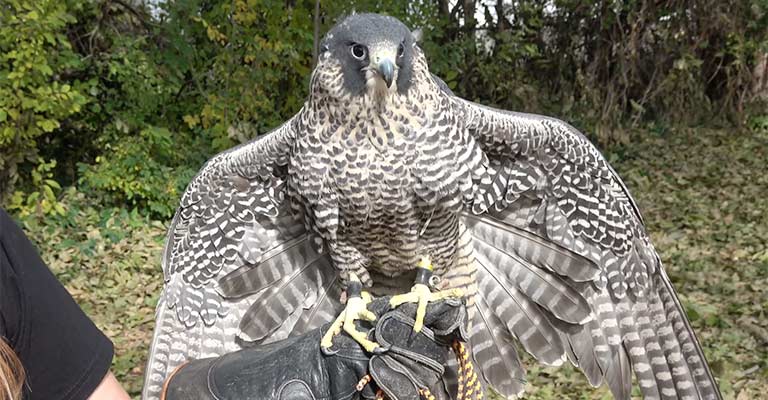
Physical Characteristics of Accipiter
Accipiters are a group of birds of prey known for their distinctive physical characteristics and hunting behavior.
Identifying these raptors can be a challenging yet rewarding endeavor for bird enthusiasts and ornithologists. Here are some key points to help you recognize and distinguish accipiters:
Size and Shape
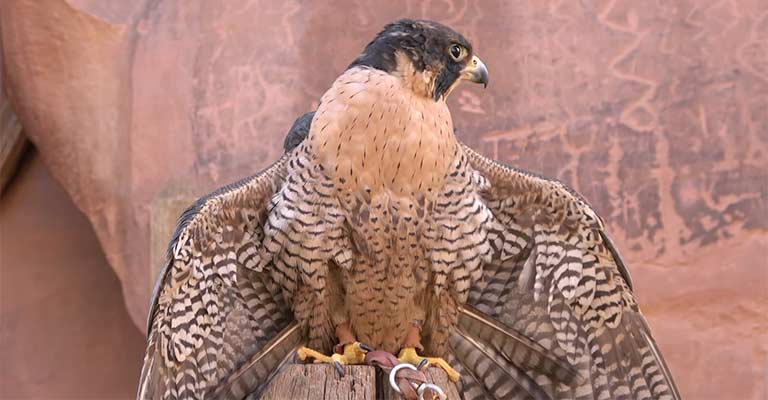
Accipiters are generally medium-sized hawks with a compact and robust build. Their bodies are streamlined, allowing for quick and agile flight.
One of the primary features distinguishing accipiters from other hawks is their relatively short wings and long tails, giving them a distinctive silhouette.
Flight Pattern
Accipiters are renowned for their rapid and acrobatic flight. They exhibit a characteristic flight pattern called “flap-flap-glide,” where they rapidly beat their wings a few times and then glide.
This flight style allows them to navigate through dense vegetation with precision, which is crucial for their hunting strategy.
Head and Beak
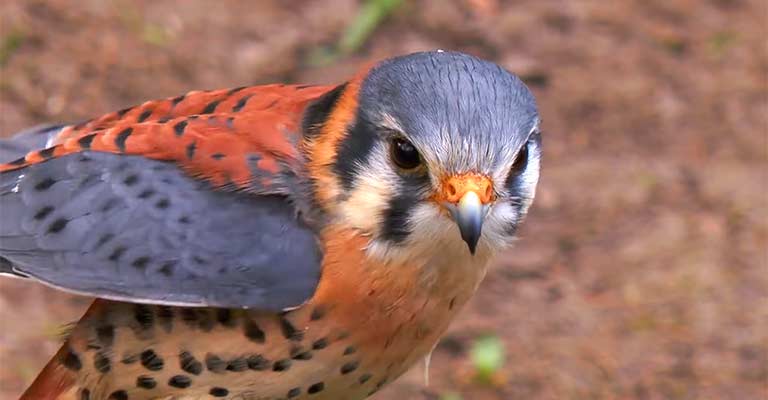
Accipiters typically have short, rounded wings and a large, broad head.
The facial features include a sharp, hooked beak designed for tearing flesh and a pronounced brow ridge, giving them a fierce and determined appearance.
Their keen eyesight is adapted for spotting prey from a distance.
Plumage and Coloration
The plumage of accipiters varies, but many species share a similar color pattern. Adult accipiters often have a dark cap on their heads, contrasting with a lighter nape.
The upperparts are usually darker, while the underparts may exhibit streaks or bars. These markings aid in camouflage while hunting in wooded areas.
Tail Features
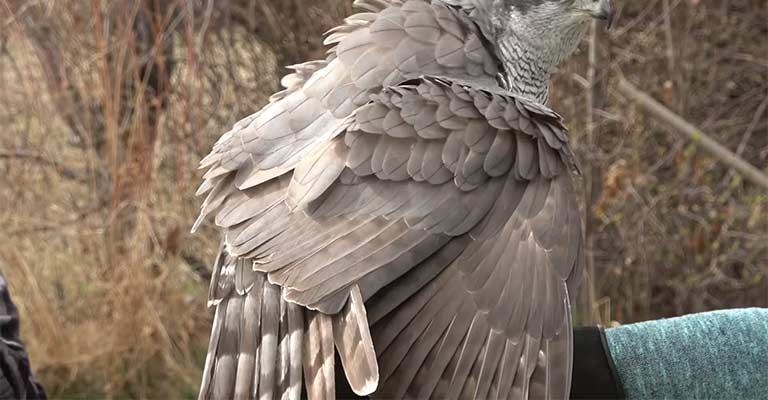
Pay close attention to the tail, as it is a crucial identifier for accipiters. These birds have long tails with rounded or squared tips.
The tail acts as a rudder during flight, aiding in their agility. The shape and length of the tail can help distinguish between different accipiter species.
Eye Color and Facial Markings
Accipiters often have striking facial markings, including a distinctive dark stripe running through their eyes.
The eye color can also be a helpful identifier; many accipiters have bright yellow or orange eyes that contribute to their intense and focused gaze.
Habitat Preference
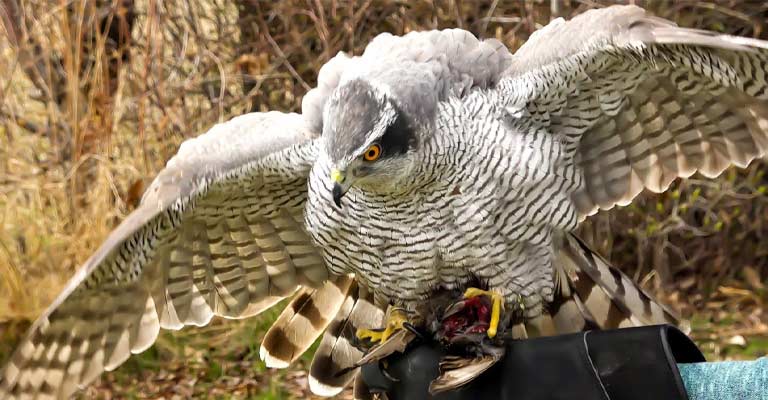
Accipiters are commonly found in wooded areas, forests, and dense vegetation where they can employ their agile flight and ambush tactics.
They are adapted for hunting in these environments, using cover to get close to their prey before launching a surprise attack.
Behavioral Traits
Watch for specific hunting behaviors that are characteristic of accipiters. They are known for their stealthy approach, often perching inconspicuously before launching a sudden attack.
Accipiters primarily prey on birds, and their hunting strategy involves surprise and quick pursuit.
Identifying accipiters requires a keen eye for specific physical features, flight patterns, and behaviors.
Observing these raptors in their natural habitats provides a fascinating glimpse into their specialized adaptations for successful hunting in wooded environments.
Taxonomy of Accipiter
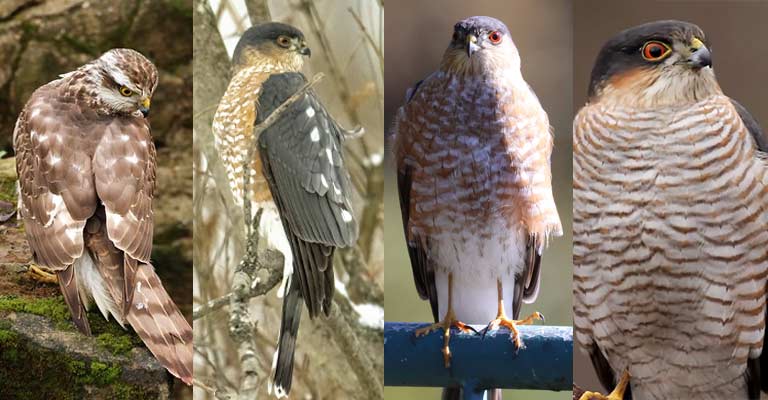
Here’s a table summarizing the taxonomy details of Accipiter:
| Taxonomic Level | Classification |
| Domain | Eukaryota |
| Kingdom | Animalia |
| Phylum | Chordata |
| Class | Aves |
| Order | Accipitriformes |
| Family | Accipitridae |
| Subfamily | Accipitrinae |
| Genus | Accipiter |
| Authority | Brisson, 1760 |
This table outlines the hierarchical classification of Accipiter, providing an overview of its taxonomic position in the biological classification system.
The list comprises various subspecies and closely related species within the Accipiter genus, highlighting the diversity within the Accipitridae family. Let’s explore some information about each of these birds:
- Accipiter striatus velox: This subspecies is commonly known as the Northern Sharp-shinned Hawk. It is recognized for its compact size, short wings, and long tail. The velox subspecies is found in North America and is known for its agile and swift flight.
- Accipiter striatus madrensis: The Madrean Cooper’s Hawk is a subspecies found in the southwestern United States and Mexico. It exhibits variations in plumage and size compared to other Cooper’s Hawks.
- Accipiter striatus fringilloides: This subspecies, known as the Puerto Rican Sharp-shinned Hawk, is endemic to Puerto Rico. It has adapted to the island’s unique ecosystem and displays distinct characteristics compared to mainland populations.
- Accipiter striatus striatus: The Eastern Cooper’s Hawk, found in eastern North America, is a well-known subspecies with a diverse range of plumage variations. It is recognized for its remarkable hunting abilities.
- Accipiter striatus suttoni: The Northwestern Cooper’s Hawk, residing in the Pacific Northwest of North America, exhibits features distinguishing it from other subspecies. Its distribution is primarily in coastal and forested regions.
- Accipiter cirrocephalus papuanus: This species, also known as the New Britain Goshawk, is found in New Britain and New Ireland in Papua New Guinea. It belongs to the broader Accipiter genus but represents a distinct and localized population.
- Puerto Rican sharp-shinned hawk: This refers to Accipiter striatus fringilloides, an endemic subspecies found in Puerto Rico. It has adapted to the unique environmental conditions of the island.
- Accipiter gentilis schvedowi: The subspecies Schvedow’s Goshawk is a variety of Northern Goshawk found in Central Asia. It exhibits characteristics specific to its geographical range.
- Accipiter nisus nisus: This subspecies is known as the Eurasian Sparrowhawk, commonly found in Europe and Asia. It is recognized for its swift flight and agility while hunting small birds.
These Accipiter species and subspecies showcase the adaptability and diversity within the genus, each tailored to its specific geographic range and ecological niche.
Studying these variations enhances our understanding of avian evolution and adaptation across different regions.
Accipiter Life History
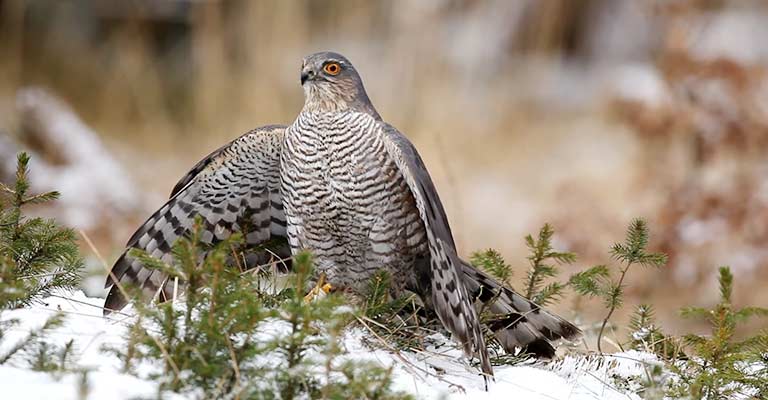
Accipiters, a group of birds of prey characterized by their agile flight and predatory prowess, encompass several species such as the Cooper’s hawk, sharp-shinned hawk, and goshawks.
Understanding the life history of accipiters involves exploring various aspects of their existence, from their preferred habitats and feeding habits to their breeding behavior and conservation status.
Food
Accipiters are carnivorous birds with a diet primarily consisting of other birds. Their remarkable hunting abilities allow them to pursue and capture prey in flight.
Small to medium-sized birds such as sparrows, finches, and thrushes are common targets, but larger accipiters may prey on game birds and mammals.
These raptors rely on their sharp talons and hooked beaks to subdue and consume their catch.
Habitat
Accipiters exhibit a diverse range of habitat preferences, but they are generally associated with wooded environments.
They thrive in forests, wooded areas, and even urban parks with sufficient vegetation, as this provides cover for their stalking and ambushing strategies.
The presence of suitable prey populations is a key factor influencing their choice of habitat.
Range Map
Accipiters are found on every continent except Antarctica, displaying a broad distribution.
A range map for accipiters reveals their adaptability to various ecosystems, including North and South America, Europe, Asia, and Africa.
Different species may have more specific ranges, and studying these maps aids in understanding their global distribution.
Nesting
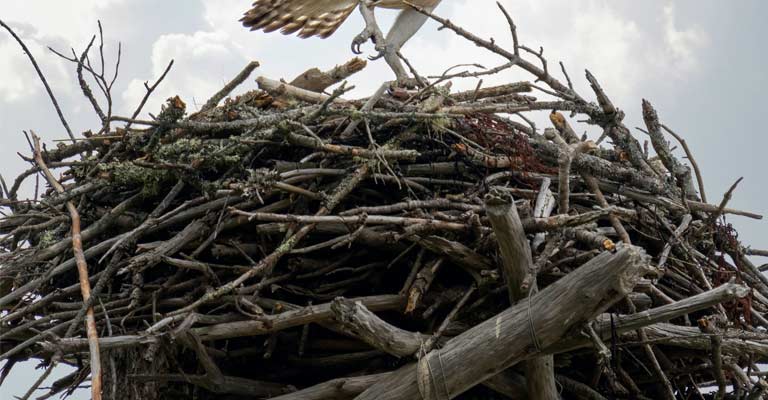
Accipiters are known for their elaborate courtship displays and the construction of well-hidden nests. They prefer to build their nests in the canopy of tall trees, adding an extra layer of protection for their offspring.
The nests are often made of sticks and lined with softer materials. Nesting sites are carefully chosen to provide a strategic vantage point for hunting and observing their territory.
Here’s a table summarizing nesting details for Accipiters:
| Nesting Details | Cooper’s Hawk | Sharp-shinned Hawk | Goshawk |
| Clutch Size | 3-5 eggs | 4-5 eggs | 2-4 eggs |
| Number of Broods | Usually 1 per year | 1 per year | Typically 1 per year |
| Egg Length | 48-56 mm (1.9-2.2 in) | 33-41 mm (1.3-1.6 in) | 58-73 mm (2.3-2.9 in) |
| Egg Width | 38-46 mm (1.5-1.8 in) | 27-32 mm (1.1-1.3 in) | 45-54 mm (1.8-2.1 in) |
| Incubation Period | 30-36 days | 30-35 days | 28-38 days |
| Nestling Period | 27-34 days | 20-24 days | 28-35 days |
| Egg Description | Bluish-white with spots | Pale bluish-white | Whitish with fine spots |
| Nest Type | Stick platform | Stick platform | Large stick platform |
Please note that these details can vary among individual birds and populations, but the provided information offers a general overview of the nesting characteristics for these three common Accipiter species.
Breeding
Breeding season for accipiters typically occurs in the spring. Courtship displays involve impressive aerial acrobatics and vocalizations. Once a pair has formed a bond, they work together to raise their young.
The female lays a clutch of eggs, and both parents participate in incubation and the subsequent care of the chicks. Accipiters are known for their territorial nature during the breeding season.
Diseases
Like many bird species, accipiters may be susceptible to various diseases. Avian diseases, including West Nile virus, can impact their populations.
Monitoring for signs of illness, such as lethargy or changes in behavior, is crucial for understanding and addressing potential health issues in accipiter populations.
Treatment
When diseases are identified in accipiter populations, conservationists and wildlife rehabilitators work together to implement treatment strategies.
This may involve veterinary care, rehabilitation, and, in some cases, population management efforts to prevent further spread of diseases.
Conservation initiatives often focus on both treating individual birds and addressing broader environmental factors.
Conservation
Accipiters face various threats, including habitat loss, pesticide exposure, and persecution. Conservation efforts aim to mitigate these threats and ensure the long-term survival of accipiter species.
Protecting their habitats, raising awareness about the importance of these raptors in maintaining ecosystem balance, and advocating for responsible pesticide use are crucial components of accipiter conservation.
The life history of accipiters is a fascinating tapestry of adaptation, behavior, and ecological interdependence.
By delving into their food preferences, habitat choices, nesting habits, and the challenges they face, we gain valuable insights into the intricate lives of these remarkable birds of prey.
10 Fun Facts About Accipiter
Accipiters, the agile and formidable birds of prey, possess intriguing features and behaviors that make them captivating subjects for bird enthusiasts. Here are 10 fun facts about Accipiters:
- Stealthy Hunters: Accipiters are known for their exceptional hunting skills. They employ a stealthy approach, using dense vegetation and rapid flight to surprise and capture their prey.
- Raptor Ambush: These birds are masters of the ambush. Accipiters often perch inconspicuously, patiently waiting for the right moment to launch a surprise attack on unsuspecting prey.
- Territorial Nature: Accipiters are fiercely territorial during the breeding season. They defend their nesting territories vigorously, engaging in aerial displays and vocalizations to ward off intruders.
- Distinctive Flight Style: Recognizable by their unique flight pattern, accipiters engage in a characteristic “flap-flap-glide” motion. This style enables them to navigate through dense forests and wooded areas with precision.
- Camouflaged Plumage: The plumage of accipiters often features cryptic patterns, aiding in camouflage while perched or hunting amidst foliage. This helps them blend seamlessly into their wooded habitats.
- Agile Acrobats: Accipiters are agile fliers, capable of impressive aerial acrobatics. Their ability to navigate through dense vegetation showcases their agility and adaptability in challenging environments.
- Eye-catching Eyes: Sporting bright yellow or orange eyes, accipiters have a fierce and intense gaze. Their keen eyesight is crucial for spotting prey from a distance and executing precise aerial maneuvers.
- Global Distribution: Accipiters are found on nearly every continent, emphasizing their adaptability to various ecosystems. From North and South America to Europe, Asia, and Africa, these raptors have a broad global distribution.
- Nest-building Expertise: Accipiters construct well-hidden nests in the canopies of trees, showcasing their nest-building expertise. The nests are made of sticks and lined with softer materials, providing a secure environment for raising their young.
- Role in Ecosystem Balance: As top predators, accipiters play a vital role in maintaining ecosystem balance. They help control populations of smaller birds and mammals, contributing to the overall health and dynamics of their habitats.
Accipiters are not only skilled hunters but also fascinating creatures with a range of behaviors that highlight their adaptability and importance in the natural world.
These fun facts offer a glimpse into the lives of these remarkable birds of prey.
Wrapping Up
Accipiters, with their stealthy hunting techniques, distinctive flight patterns, and global adaptability, emerge as captivating and essential contributors to ecosystem dynamics.
Their camouflaged plumage, agile acrobatics, and territorial nature further underscore their remarkable characteristics.
Accipiters play a crucial role in maintaining ecological balance by controlling prey populations, showcasing the intricate interdependence of species in the natural world.
Whether perched inconspicuously in wooded habitats or executing precise aerial maneuvers, these birds of prey exemplify the beauty and resilience of avian predators. Thank you so much.
